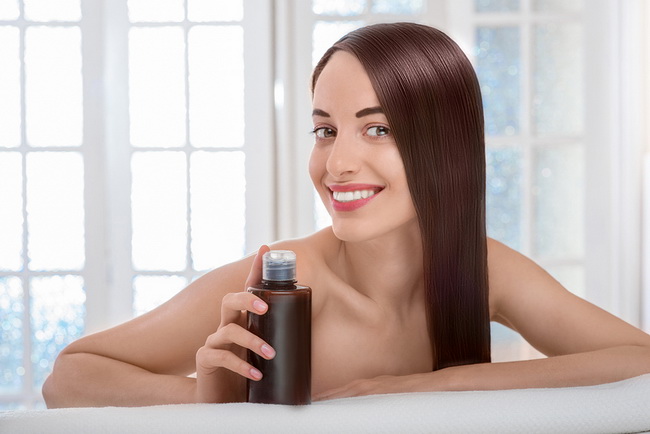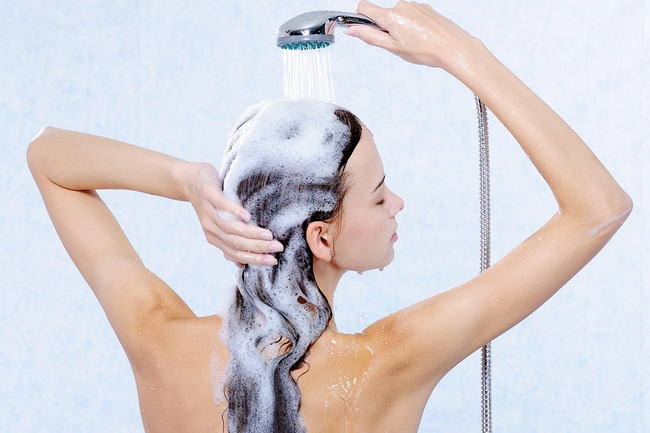- Make It Yourself Lavender Heart-Shaped Bath Bombs!
- 20 Things You Never Knew About “Down There”
- 12 Best Foods For Those Suffering From Arthritis Pain
- 12 Personal Hygiene Mistakes Almost Everyone Makes (Mom Never Told You About #4!)
- 15 Medicinal Plants And Herbs From The Cherokee People
- 12 Mind-Blowing Benefits Of Drinking Coconut Water During Pregnancy
- 12 Outstanding Winter Foods That Won’t Fatten You Up Like A Christmas Turkey
12 Toxic Compounds Hiding In This One Thing You Use Every Single Day

Photo credit: bigstock.com
There is one “necessity” in every house that most people don’t give much thought to. Certainly not to the ingredients. You probably have a favorite brand or you might switch between three or four brands; perhaps you just buy whatever is on sale, many people do. But regardless of which brand you buy or how much it costs one thing remains, it is probably full of toxic chemicals.
Would you ever consider washing your hair with formaldehyde? Anti-freeze? Or engine degreaser? Of course not! Yet, those are some of the chemicals that are hiding in plain sight in your shampoo. You might be thinking, “Who cares? It’s not like I drink my shampoo!” True, but consider this; at least the things you eat get processed by your stomach, the liver, and your intestines first. You cannot say the same thing about the stuff you put on your skin and scalp. Whatever you put on your skin goes directly into your blood: no filter, no dilution, nothing. This means that that engine degreaser you just put on your head went right into your bloodstream and is circulating throughout your body.
Not sure that you believe that? How do you think that nicotine patch works? Or pain reliving patches? Worse still, once your skin is warm from that nice, hot shower, your pores are wide open and ready to receive anything you put on them.
If you have been experiencing health problems that your doctor cannot pin down, the answer might be as simple as changing your shampoo. These toxic ingredients in shampoo can cause problems such as skin irritation, flaky skin, overly dry skin, rashes, allergies, sinusitis, asthma, difficulty breathing, and even certain types of cancer. The chemicals in most shampoos are known to weaken the immune system as your body tries to deal with them. This can lead to frequent colds, flus, and persistent fungal infections.
Doesn’t that sound clean and healthy?
Curious to know which are the 12 most offending ingredients? Keep reading, then check and see if any of the following chemicals are in your shampoo. Afterwards, we will talk about safe alternatives.
1. Polyethylene Glycol
Most times, this is listed as PEG. This chemical is petroleum based and is used to give your shampoo its creamy texture. PEG is listed as a known carcinogen and can be contaminated with other carcinogens such as ethylene oxide. PEG has been shown to cause irritation and systemic toxicity if exposed to broken skin.
Continue to Page 2

Photo credit: bigstock.com
2. Parabens
Parabens are chemical preservatives that are in shampoo and just about every other personal care product you use. Parabens have been linked to organ toxicity and damage to the reproductive system even at very low doses. In one study, inside the breast tissue of 40 women who had had mastectomies due to breast cancer, it was discovered that 99 percent of the cancerous tumors contained parabens. Parabens mimic estrogen and have been linked in studies to certain cancers that are fueled by excessive estrogen levels.
3. Diethanolamine
Also known as DEA, this chemical is used to give you that rich lather that most people expect in a shampoo. DEA is known to react with other chemicals to create a very dangerous and potent carcinogen called nitrosodiethanolamine, or NDEA. This cancer causing chemical is easily absorbed into the skin and has been linked to stomach cancer, bladder cancer, liver cancer, and esophageal cancer.
4. Sodium Lauryl Sulphate
Sometimes referred to as SLS, this compound is literally a detergent that is used to break down surface tension so shampoos can work better. This chemical has been linked to potent carcinogens called nitrosamines, which cause your body to absorb more nitrates. There are more than 40,000 studies listed in the PubMed science library that show that this compound is toxic and is believed to cause cancer.
5. Fragrances
Synthetic fragrances can contain hundreds, maybe even thousands, of chemicals, including dangerous phthalates. Since scents are a protected trade secret, companies do not have to disclose exactly what chemicals they are using to create these fragrances. Perfumes, fragrances, and scents are one of the major causes behind allergic reactions and asthma.
Continue to Page 3

Photo credit: bigstock.com
6. Sodium Laureth Sulphate
Similar to SLS, this is often shortened on labels as SLES. Depending on the manufacturing process, SLEs often becomes contaminated with Diozane, which is a suspected carcinogen. The liver has a difficult time metabolizing these chemicals, which means that these can stay in the body for long periods of time and accumulate.
7. Methylisothiazolinone
That’s a mouthful, isn’t it? This is a preservative which has long been associated with allergic reactions. In studies done with mammals, this chemical has been shown to damage the brain cells and is considered to be a neurotoxin. This chemical is very irritating to most people and is mostly used in products that are intended to be rinsed off because of it.
8. Propylene Glycol
Yep, this is the same stuff that you are using in the radiator of your car, commonly called antifreeze! You will find this in many shampoos, hand sanitizers, and hair conditioners. Although on a bottle of antifreeze they recommend that you do not allow this product to come in to contact with your skin, it is used in many personal care products for some reason. This chemical has been linked to kidney damage and liver problems.
9. Methylchloroisothiazolinone
If you thought other names were bad, this one is worse. Words like this alone should warn you that what you are using is not natural and not meant for the human body. This is another commonly used preservative that has been linked to cancer in some studies and is a well-known irritant as well as causing allergic reactions.
10. Benzalkonium Chloride
This is another preservative that also works as an antimicrobial and surfactant in most shampoos. This chemical has been associated with allergic reactions, causes irritation to the respiratory tract, and severe eye and/or skin irritation.
Continue to Page 4

Photo credit: bigstock.com
11. Formaldehyde
Also known as Quaternium 15, this is a time releasing preservative. There are more than 84 studies in the PubMed science library which include information about the toxicity of formaldehyde. In the Skin Deep database, on a scale of 0 to 10, this product is an astounding 8. Even the European Union lists this chemicals as “probably not safe” on their cosmetics and have discussed banning it altogether. You will find this in almost all shampoos sold today.
12. Cocamidopropyl Betaine
This is an overall hazard that is linked to allergic contact dermatitis and other types of skin irritation. PubMed states that the increasing rates of sensitization have led to this chemical being give the honor of being named Allergen of the Year back in 2004.
Want some better choices?
First, research the company you buy from. Check out their product lines and see if they are using synthetic ingredients or are they focused on organic products? Do they do 3rd party testing? Do they offer certification of their products?
You should also read labels. This can be difficult because most ingredients are listed by abbreviations and some terms are rather ambiguous. Take the word “natural” for example. Natural can mean just about anything. There are no laws regulating this word so a manufacturer can say their product contains “natural” ingredients as long as it contains water.
Also, natural and organic are not the same thing. Organic means that a plant was grown without chemicals or pesticides, natural simply means it came from a natural source. Simply because a product says that it is organic does not mean that it contains only organic ingredients.
Perhaps the easiest way to avoid being exposed to cancer causing and dangerous chemicals is to make your own personal care products. This way you know exactly what is in your shampoo and what you are exposing yourself to.
Simply Google “make your own shampoo” and you will find hundreds, if not thousands, of recipes for making your own shampoo. You can also find other recipes for making your own non-toxic personal care products such as deodorants, lotions, cosmetics, and hair conditioners.
If concocting your own personal care products is not your thing, then look for products with the genuine USDA organic seal. Read the labels. If you see words that you can’t pronounce, then you probably don’t want to put it on your body or on your scalp. One of the best ways to avoid toxins is to look for products that are fragrance free. This will literally save you from hundreds or thousands of chemicals.
Also, if you are not aware of it, manufacturers must list the ingredients in descending order by volume. This means that the first ingredient on the list is what the product has the most of and the last item is what the product contains the least of. So if your “all natural chamomile” shampoo lists chamomile as the last ingredient, it certainly doesn’t contain enough chamomile to really make a difference, now does it?
READ ALSO: Top 8 Dangerously Toxic Cleaning Chemicals to Avoid
Also, look for products that come in glass, rather than BPA plastics, if you can find them.
Support companies that are earth friendly, animal friendly, human friendly, and green. Let’s support human health and care for Mother Earth and Mother Nature at the same time.
References:
































